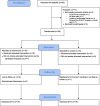Effectiveness of text messages for decreasing inactive behaviour in patients with knee osteoarthritis: a pilot randomised controlled study
- PMID: 31516729
- PMCID: PMC6732192
- DOI: 10.1186/s40814-019-0494-6
Effectiveness of text messages for decreasing inactive behaviour in patients with knee osteoarthritis: a pilot randomised controlled study
Abstract
Background: One of the big contributors to physical inactivity in the elderly population is osteoarthritis (OA) of the knee. Digital motivation seems to have a positive effect on individual physical inactivity level, but limited evidence exists on the effects of digital motivation on patients with knee OA.
Objective: To investigate if motivational text messages reduce time spent physically inactive in patients with knee OA.
Method: This study was designed as an unblinded pilot randomised controlled trial, randomising participants equally (1:1) to an intervention group (motivational text messages) or control group (no intervention). Participants were recruited from six physical therapy clinics in Denmark. Inclusion criteria were age ≥ 18, diagnosed with knee OA, owner of a smartphone or tablet, and participating or commencing participation in the GLA:D® program. The primary outcome was time spent physically inactive, measured with a tri-axial accelerometer mounted on the lateral side of the thigh. Data on OA symptoms were obtained using the Knee injury and Osteoarthritis Outcome Score (KOOS) questionnaire.
Results: A total of 49 participants were screened, and 38 participants were included and randomised to either the intervention group (n = 19) or the control group (n = 19). No statistically significant difference between the two groups was found in average change of time spent physically inactive (mean difference 13.2 min/day [95% CI - 41.0 to 67.3]; P = 0.63), time spent standing (mean difference 3.0 min/day [95% CI - 22.7 to 28.7]; P = 0.81), or time spent moving (mean difference - 20.4 min/day [95% CI - 63.0 to 22.3]; P = 0.34) nor was there any difference in change between the two groups on KOOS.
Conclusion: Motivational text messages have seemed to have no effect on overall time spent physically inactive.
Trial registration: clinicaltrials.gov, NCT03339011. Registered 9 November 2017.
Keywords: Accelerometer; Knee osteoarthritis; Physical inactivity; Text messages.
Conflict of interest statement
Competing interestsThe authors declare that they have no competing interests.
Figures


Similar articles
-
Changes in physical inactivity during supervised educational and exercise therapy in patients with knee osteoarthritis: A prospective cohort study.Knee. 2020 Dec;27(6):1848-1856. doi: 10.1016/j.knee.2020.09.007. Epub 2020 Nov 13. Knee. 2020. PMID: 33197825
-
Association Between Weight Loss and Spontaneous Changes in Physical Inactivity in Overweight/Obese Individuals With Knee Osteoarthritis: An Eight-Week Prospective Cohort Study.Arthritis Care Res (Hoboken). 2020 Mar;72(3):397-404. doi: 10.1002/acr.23868. Epub 2020 Feb 17. Arthritis Care Res (Hoboken). 2020. PMID: 30821925
-
Effectiveness of a web-based physical activity intervention in patients with knee and/or hip osteoarthritis: randomized controlled trial.J Med Internet Res. 2013 Nov 22;15(11):e257. doi: 10.2196/jmir.2662. J Med Internet Res. 2013. PMID: 24269911 Free PMC article. Clinical Trial.
-
Exercise therapy and patient education versus intra-articular saline injections in the treatment of knee osteoarthritis: an evidence-based protocol for an open-label randomised controlled trial (the DISCO trial).Trials. 2021 Jan 6;22(1):18. doi: 10.1186/s13063-020-04952-5. Trials. 2021. PMID: 33407791 Free PMC article.
-
Capitalizing on the teachable moment: osteoarthritis physical activity and exercise net for improving physical activity in early knee osteoarthritis.JMIR Res Protoc. 2013 May 9;2(1):e17. doi: 10.2196/resprot.2553. JMIR Res Protoc. 2013. PMID: 23659903 Free PMC article.
Cited by
-
Applications of Wearable Technology in a Real-Life Setting in People with Knee Osteoarthritis: A Systematic Scoping Review.J Clin Med. 2021 Nov 30;10(23):5645. doi: 10.3390/jcm10235645. J Clin Med. 2021. PMID: 34884347 Free PMC article.
-
Applications of Digital Health Technologies in Knee Osteoarthritis: Narrative Review.JMIR Rehabil Assist Technol. 2022 Jun 8;9(2):e33489. doi: 10.2196/33489. JMIR Rehabil Assist Technol. 2022. PMID: 35675102 Free PMC article. Review.
-
Behavior Change Text Messages for Home Exercise Adherence in Knee Osteoarthritis: Randomized Trial.J Med Internet Res. 2020 Sep 28;22(9):e21749. doi: 10.2196/21749. J Med Internet Res. 2020. PMID: 32985994 Free PMC article. Clinical Trial.
-
Effect of exercise and/or educational interventions on physical activity and pain in patients with hip/knee osteoarthritis: A systematic review with meta-analysis.PLoS One. 2022 Nov 21;17(11):e0275591. doi: 10.1371/journal.pone.0275591. eCollection 2022. PLoS One. 2022. PMID: 36409668 Free PMC article.
-
Impact of COVID-19 Pandemic on Physical Activity, Pain, Mood, and Sleep in Adults with Knee Osteoarthritis.J Meas Phys Behav. 2022 Dec;5(4):294-298. doi: 10.1123/jmpb.2022-0019. Epub 2022 Sep 28. J Meas Phys Behav. 2022. PMID: 36779003 Free PMC article.
References
-
- WHO . Global Health Risks. Report. 2009.
-
- Ekelund U, Steene-Johannessen J, Brown WJ, Fagerland MW, Owen N, Powell KE, et al. Does physical activity attenuate, or even eliminate, the detrimental association of sitting time with mortality? A harmonised meta-analysis of data from more than 1 million men and women. Lancet. 2016;388(10051):1302–1310. doi: 10.1016/S0140-6736(16)30370-1. - DOI - PubMed
Associated data
LinkOut - more resources
Full Text Sources
Medical

